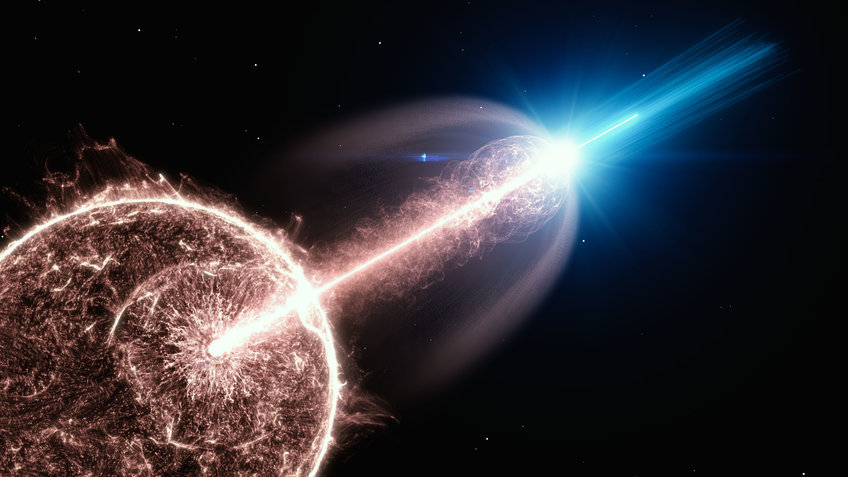The strange afterglow of a gamma-ray burst
Using the H.E.S.S. observatory, researchers at GRB 190829A observe unusual features that challenge models
Researchers from the H.E.S.S. Collaboration succeeded to derive the intrinsic spectrum of the very-high-energy gamma-ray afterglow emission of a relatively nearby gamma-ray burst. Sur-prisingly, the gamma-ray spectrum resembles that of the much lower-energy X-rays, while the fading emission from both bands was observed to march in parallel over three nights. These remarkable findings challenge the current emission scenarios.

Gamma-ray bursts (GRBs) are bright X-ray and gamma-ray flashes observed in the sky, emitted by distant extragalactic sources. They are associated with the creation or merging of neutron stars or black holes; processes which result in an explosive outburst of material moving incredibly close to the speed of light. The initial flashes, which last a few seconds, are followed by a long-lived afterglow phase that can be detectable for several days in X-rays, and often weeks or even months in the optical and radio bands. It was this afterglow emission that first confirmed the extragalactic origin of GRBs. The X-ray afterglow radiation is produced by accelerated electrons interacting and losing energy within the blast wave magnetic field. This energy is radiated in the form of synchrotron photons.
GRB afterglows are considered to be an excellent cosmic laboratory for studying acceleration of particles in the cosmos, due to the apparent simplicity of the underlying physics. This is in contrast with the prompt phase which is extremely complex. Many aspects of the afterglow emission are well known in X-rays, but the very-high-energy (VHE, >100 GeV) emission – six orders of magnitude more energetic than X-rays – has been a missing piece of the multi-wavelength puzzle.
In the VHE regime, making a detection is particularly challenging since the distant Universe is not fully transparent to VHE gamma rays due to their absorption in the background light that permeates the Universe. In recent years, major steps have been made toward the understanding of GRBs at VHEs with two detections, the first observed 10 hours after the afterglow onset and the second within the first hour of the afterglow. Both were observable for no more than two hours and happened at moderate cosmological distances, limiting the highest energy in the spectrum that could be probed. The process responsible for the most energetic emission, however, remained inconclusive.

Now, the international team of researchers operating the H.E.S.S. (High Energy Stereoscopic System) array of atmospheric Cherenkov telescopes, reported the detection of a third GRB – at a redshift of only z = 0.0785, a mere 1 billion light-years away. “A gamma-ray burst occurring in our cosmic backyard like this one, is a very rare thing, and a fantastic opportunity to understand what is going on at the highest energies” – mentioned Jim Hinton, director at MPIK.
On 29 August 2019, the Fermi Gamma-Ray Burst Monitor and the Swift Burst Alert Telescope detected and localised GRB 190829A. Subsequently, ground-based observatories including H.E.S.S. turned to look at this position to monitor the evolution of this burst over a very wide range of wavelengths. Observations with H.E.S.S. started 4 hours after the burst, when the source became visible to its telescopes. Edna Ruiz Velasco, a PhD student from MPIK, was one of the lead investigators in the work: “We have been able to cover the GRB afterglow from 4 to 56 hours after the initial explosion and measure its emission very accurately”. Dmitry Khangulyan, a H.E.S.S. member from Rikkyo University in Japan, and an MPIK alumnus, added: “This new result provides two new and unique observational insights about GRB afterglows.”
The accurate determination of the spectrum over more than an order of magnitude in energy, from 0.18 to 3.3 TeV, and covering an extended temporal range of several days, was made possible by a combination of good instrumental sensitivity and the fortuitous proximity of the GRB. Such accurate measurements over a broad energy range have allowed the intrinsic VHE spectrum to be reliably probed for the first time. As Carlo Romoli, a post-doctoral researcher at MPIK noted, “these new results have revealed curious similarities between the X-ray and VHE gamma-ray emission”.
Such a strong connection, however, is unexpected in standard GRB theory, which predicts a separate origin for the VHE component. In this theory, synchrotron emission up to VHE gamma rays is not possible, since a maximum energy is placed on the electrons. The observations by H.E.S.S., however, can be explained if electrons are accelerated beyond this limit. “The far-reaching implication of this possibility highlights the need for further studies of VHE GRB afterglow emission”, mentioned Felix Aharonian, external scientific member of MPIK and at DIAS in Ireland.
As highlighted by Andrew Taylor from DESY-Zeuthen (and another MPIK alumnus), “the community is getting more and more excited about the prospects for the next generation of observatories. After decades of searching, we are finally getting closer to understanding the processes that govern this extremely energetic phenomena”. Looking to the future, the prospects for the detection of GRBs by future instruments look promising. Certainly, the abundance of GRB afterglow detections over the last few years indicates that regular detections in the VHE band will become rather common. However, a high bar has now been set by this H.E.S.S. result, which has highlighted the scientific importance of the detection at VHE of local GRBs, particularly at late times in the afterglow.
GH / HOR













